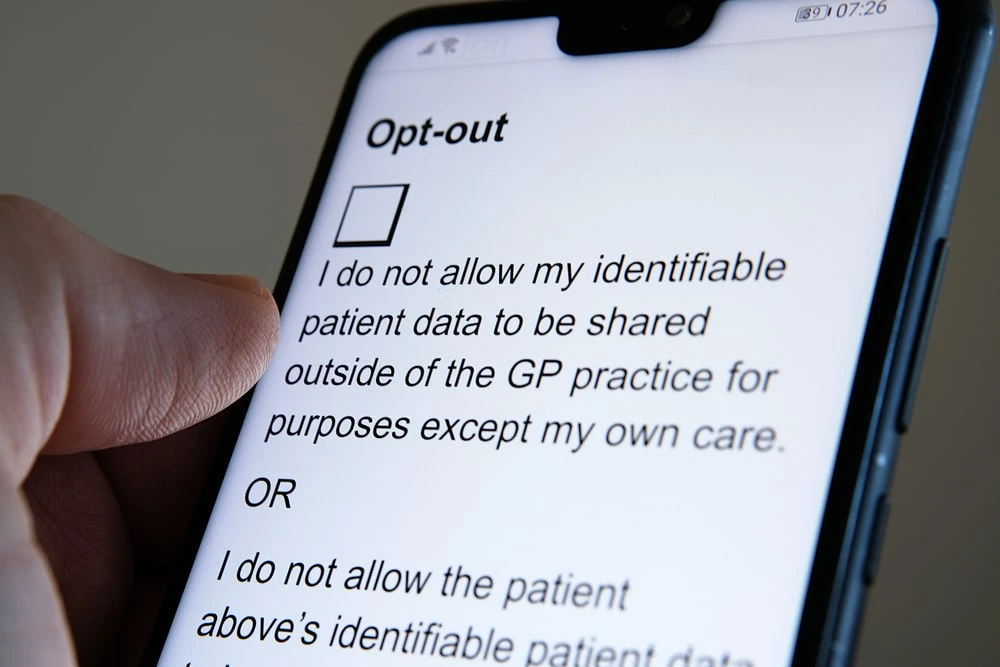6 Tips for Businesses to Prevent SMS Opt-Outs
Discover tactics to reduce SMS opt-outs, improve engagement, and keep subscribers happy. Learn how to create compliant, value-driven SMS campaigns...
Master the art of opt-in language with Sakari. Learn the dos and don'ts through practical examples, and discover how to craft compelling opt-in messages.

Crafting the perfect opt-in language is an art that balances legal compliance, builds brand trust, and secures subscriber consent, turning your email and SMS campaigns into a powerful lead magnet.
This guide dives into the finesse of creating compelling opt-in forms, requests, and messages that boost your conversion rates and deepen your connection with your audience.
In marketing, “opt” refers to a customer’s decision to either agree to receive communications (opt-in) or decline them (opt-out) from a business via channels like email or SMS.
Opting in means a customer gives explicit consent to be contacted, establishing a trust-based relationship with the business. This consent is vital for SMS compliance with legal standards and ethical marketing practices. Opt-ins ensure that businesses communicate only with individuals who have expressed a genuine interest in their messages.
On the other hand, opt-outs in marketing are mechanisms that allow subscribers to easily withdraw their consent and stop receiving communications from a business. This option is essential for empowering customers with control over their communication preferences, thereby maintaining a respectful and healthy relationship between the business and its audience.
Opt-outs are as crucial as opt-ins since they ensure that marketing practices adhere to principles of respect, consent, and customer satisfaction, and comply with legal requirements.
Including clear opt-in text message examples that specify the call to action and how to unsubscribe—such as "Reply STOP to unsubscribe"—ensures customers understand their rights.
Customers must opt-in to emails and SMS, a practice mandated by laws like the General Data Protection Regulation (GDPR) in Europe, the CAN-SPAM Act in the U.S., and the Telephone Consumer Protection Act (TCPA) in the U.S. These regulations ensure businesses respect customer privacy, preferences, and consent. This requirement not only fulfills legal obligations but also offers several advantages for businesses:
Opt-Ins Prevent Spam: By adhering to opt-in requirements, businesses avoid sending unsolicited communications, thereby maintaining a positive brand image and avoiding potential penalties associated with spamming.
It Enhances Engagement: Opt-in leads to a more interested and engaged audience. Businesses benefit from higher open and response rates, as communications are sent to individuals who have actively expressed interest.
It Builds Trust: When customers voluntarily opt-in, it establishes trust in the brand. This trust can lead to increased customer loyalty and a higher likelihood of repeat business.
It Allows Data Protection Compliance: Compliance with data protection laws not only avoids legal repercussions but also positions a business as responsible and trustworthy in handling customer data.
Opt-Ins Ensure Quality over Quantity: Opting in results in a more qualified audience for marketing efforts. This leads to more effective campaigns and a better return on investment, as the audience is more likely to be interested in the products or services offered.
It Helps With Targeting and Personalization: With accurate data from opt-in subscribers, businesses can tailor their marketing strategies more effectively, leading to higher conversion rates through personalized and targeted content.
It Supports Long-Term Customer Relationships: Opt-in practices lay the foundation for sustained customer relationships. These relationships are built on mutual respect and interest, leading to long-term customer retention and value.
A good opt-in message should be clear, concise, and transparent, effectively communicating what the recipient is signing up for, the frequency of messages, and how to opt-out.
For example, an effective SMS opt-in message could be: “Get weekly updates on our latest products and special offers! Text YES to subscribe. You can text STOP at any time to unsubscribe.”
This message format ensures clarity, respects the recipient’s choice, and effectively communicates the key details, making it an ideal example for SMS marketing opt-in communications.
Not all opt-ins are equal, nor are they compliant. Crafting effective opt-in language is crucial for compliance and subscriber engagement. Here are key best practices to ensure your opt-ins are both compliant and compelling:
Offer Clear and Precise Information:
Clearly articulate what subscribers are opting into. If your texts are about promotional messages, state it directly. For SMS appointment reminders, specify this. Offer separate opt-in paths for different content types to cater to varied subscriber preferences. This can easily be done by leveraging SMS templates.
Provide Easy Opt-Out Options:
Include straightforward opt-out instructions in every message, such as “Reply with STOP to unsubscribe.” This respects subscriber choice and simplifies data management. Always honor all forms of unsubscribe requests.
Choose Memorable Keywords for Opt-In:
Select engaging and easy-to-remember keywords for opt-in prompts. For a fitness center, “GetFit” or “Lift” can be effective. This makes the opt-in process interactive and memorable.
Keep Sign-Ups Informative and Simple:
Communicate expectations clearly and maintain a simple sign-up process. Avoid complicating the opt-in procedure unnecessarily.
Offer Value in Your Communications:
Provide incentives or valuable content as part of your opt-in messages, such as exclusive coupons or useful tips. This enhances the perceived value of your communications.
Allow Subscribers to Customize Preferences:
Give subscribers the option to customize their message types or communication frequency. This personalization can increase engagement and satisfaction.
Ensure Compliance with Regulations:
Your opt-in messages should adhere to standards set by bodies like The Campaign Registry, Zipwhip, or the Common Short Code Administration. Important compliance aspects include:
Being transparent about the content of texts.
Providing an uncomplicated process for opting out.
Ensuring opt-in records are auditable by verification organizations.
Adhering to these best practices will help you meet legal obligations and boost the effectiveness of your communication strategy.
For more detailed compliance information, refer to our in-depth 10DLC opt-in compliance guide.
8. Implement Double Opt-In for Email Marketing:
Building an effective opt-in email list is crucial for successful email and SMS marketing. Here’s how to do it:
Offer Value to Incentivize Sign-Ups: Utilize lead magnets such as free eBooks, discounts, or exclusive content to entice sign-ups. You can also offer special deals or exclusive access via text to encourage opt-ins. For instance, “Text JOIN to 12345 for weekly deals.”
Simplify the Sign-Up Process: Ensure the process is user-friendly and the value proposition is evident. A simple text-to-join message can be very effective.
Confirm Subscriptions: Send a welcome email or a welcome text to confirm new subscriptions, reinforcing the opt-in decision.

In the US, SMS marketing consent must be explicit. Acceptable forms include:
Texting a Keyword: Having customers text a specific keyword to a number, like “Text YES to 12345 to subscribe.”
Opt-In via Online Form: A digital form where customers can enter their phone number and agree to receive text messages.
Verbal Consent: Obtained during customer service calls, with clear documentation and confirmation texts sent afterward.
Acceptable forms of consent for email communication include:
Filling Out a Form: Actively entering information into a sign-up form.
Ticking a Checkbox: Manually checking a box to indicate consent (checkboxes should not be pre-ticked).
Sending a Confirmation Message: Responding to a confirmation request to verify the subscription.
These methods ensure that consent is clear, voluntary, and informed.
Certain practices are not valid for obtaining consent in SMS and email marketing:
Assumed Consent from Inactivity: Silence or lack of response does not imply consent. Failing to decline is not consent.
Automatic Enrollment: Adding customers to your email or SMS list without their explicit action to opt in.
Pre-Checked Boxes: Consent must be an active choice, not a default option.
Hidden Consent in Terms and Conditions: Consent clauses buried in lengthy documents are not considered transparent or informed.
In each case, the key issue is the lack of a deliberate, informed choice by the customer, which is crucial for valid consent.
Maximizing your opt-in rates for both SMS and email campaigns is crucial for a successful marketing strategy. Here are some proven tips to enhance your opt-in promotion efforts:
Offer Compelling Incentives:
For SMS: “Text JOIN to 12345 for an exclusive 20% off your next purchase.”
For Email: “Subscribe to our newsletter and receive a free e-book on [topic].”
Showcase Social Proof:
Use customer testimonials or highlight the number of current subscribers to build trust.
Example: “Join our community of over 15,000 happy subscribers for weekly tips and deals!”
Create Urgency with Time-Sensitive Offers:
For SMS: “Hurry! Text DEAL to 12345 within the next 24 hours for a special discount.”
For Email: “Sign up for our newsletter in the next 48 hours to enter our exclusive giveaway.”
Leverage Social Media Platforms:
Promote your opt-in links on social media, encouraging followers to join for unique content or offers.
Segment Your Audience for Personalized Messaging:
Tailor your opt-in messages to different audience segments to increase relevance and engagement.
For SMS: “Text STYLE to 12345 for fashion tips tailored to your taste!”
For Email: “Subscribe to our newsletter for personalized wellness advice.”
By implementing these strategies, you can significantly enhance the appeal of your opt-in campaigns, leading to higher engagement rates in both your SMS and email marketing efforts.
There are many ways to collect opt-ins, as shown in our SMS Opt-ins and 6 Great Ways to Get Them article. While we’ll cite many example texts below, we strongly advise creating your own:
Implement Keyword Text Requests:
Encourage customers to opt-in by texting a keyword. Suggest, “Text JOIN to 12345 for exclusive updates!” Ensure the automatic reply confirms their subscription and provides an opt-out option, like “Welcome! Text STOP to unsubscribe anytime.”
Utilize Opt-In Pop-Ups on Your Website:
Place a pop-up with an opt-in form on your website inviting visitors to subscribe to SMS updates. For instance, “Sign up for SMS alerts on special deals! Enter your number here (opt-out anytime).” Keep the pop-up informative yet unobtrusive.
Incorporate Checkout Checkbox for E-commerce:
Add opt-in checkboxes during the online checkout process. Use clear options like “☑ Yes, send me SMS updates on exclusive deals!” and “☐ Yes, I’d like order updates via text.” This lets customers choose their preferred communication.
Employ Double Opt-In for Enhanced Engagement:
Strengthen your subscriber list with a double opt-in. After initial sign-up, send a confirmation text such as, “Reply YES to confirm your subscription to our SMS alerts. Opt out with STOP.”
Additional Opt-In Examples:
For Discount Offers: “Offer a 10% discount for new SMS subscribers. Example: ‘Text DEALS to 12345 for your discount! Msg & data rates may apply. Text STOP to unsubscribe.'”
For Event Updates: “Keep your customers informed about events. Suggest: ‘Text EVENTS to 12345 for the latest updates. To opt-out, text STOP.'”
For Feedback Requests: “Encourage customer feedback via SMS. Example: ‘Text FEEDBACK to 12345 to share your thoughts. Unsubscribe with STOP anytime.'”
For Appointment Reminders: “Remind customers of their appointments. Use: ‘Text REMIND to 12345 for reminders. Text STOP to cancel alerts.'”Each of these strategies offers a unique way to engage with your audience and grow your SMS subscriber list effectively.
Ready to take your SMS marketing to the next level? Discover the power of personalized, compliant, and effective text messaging with Sakari. Our expansive platform allows businesses to send SMS to clients and customers, creating a community of engaged subscribers. Features like two-way texting and MMS ensure every organization can utilize the power of marketing messages.
Sign up for a free trial of Sakari now and experience firsthand how our tools can elevate your business’s SMS campaigns.

Adam is the Co-Founder of Sakari. Sakari is a business SMS service for sending text message alerts, reminders, events and notifications to customers and employees, wherever they are. Manage your entire business messaging in one location, with unlimited users, branch accounts and integration with over 1,300 applications.
Your email address will not be published
Discover tactics to reduce SMS opt-outs, improve engagement, and keep subscribers happy. Learn how to create compliant, value-driven SMS campaigns...
Learn how to measure and optimize your SMS Marketing ROI with proven strategies, key metrics, and real-world examples. Discover how to boost...
Learn how to easily add links to text messages to enhance your SMS marketing campaigns. Drive engagement and guide recipients to your website via a...
With our 14-day free trial, you can dive in and explore all these features, with no commitment.